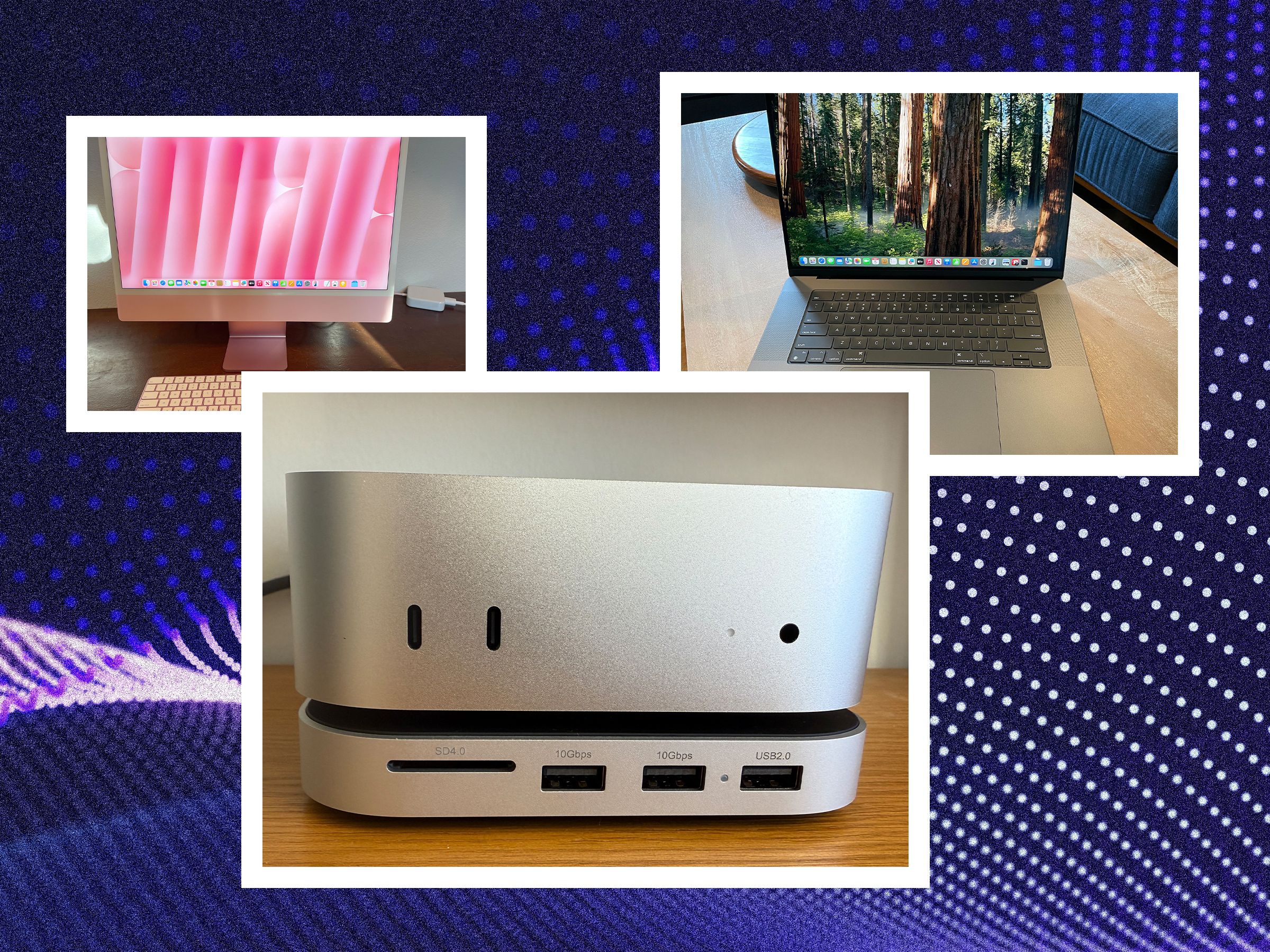If you buy something using links in our stories, we may earn a commission. Learn more.
Best for Most People
Apple iMac (M4, 2024)
Apple’s Tiniest Desktop Computer
Apple Mac Mini (M4, 2024)
The Best Upgrade
Apple Mac Studio (M4 Max)
The Expandable Mac
Apple Mac Pro
Apple desktop computers are elegant machines that can serve a family or drive a powerful home office workstation. But between the different models and chipsets, it can be a struggle to find the best Mac for your needs. Whether you’re a creative professional looking for a machine that can handle graphic design tasks or a student in need of a reliable PC to get work done, Apple has a wide range of options. From the stylish and easy-to-use iMac to the powerful Mac Studio, we break down Apple’s offerings to help you find the Mac best suited for your everyday tasks.
Be sure to check out our other Apple and home office buying guides, including the Best MacBooks, Best MacBook Accessories, Best iPads, Best iPhones, and Best Home Office Gear.
Power up with unlimited access to WIRED. Get best-in-class reporting that’s too important to ignore for just $2.50 $1 per month for 1 year. Includes unlimited digital access and exclusive subscriber-only content. Subscribe Today.
What Is the Latest M-Series Chip?
Apple first started designing its in-house chips back in 2020, which are dispersed throughout different Macs, MacBooks, and iPads. As of now, the company has released a total of 14 M-series chips. As new versions come out, machines with older chips are discontinued at Apple and tougher to find at third-party retailers.
The M4 series is the current generation of silicon from Apple. There’s a choice between an M4, M4 Pro, and M4 Max. Each chip is built on a second-generation 3-nanometer process, which fits more transistors into a smaller space to enhance speed and efficiency. Both the M4 Pro and M4 Max come with mesh shading and ray tracing too, which Apple says is twice as fast as on the M3 chip.
The M4 (with a 10-core CPU and 10-core GPU) is the entry-level option and best for basic tasks. The M4 Pro (with a 14-core CPU and an up to 20-core GPU) is the better option for those who need a bit more power for tasks like heavy-duty video or photo editing. The M4 Max (with a 16-core CPU and up to a 40-core GPU) is the most powerful chip you can get in a MacBook but the second-most-powerful chip available in a Mac desktop.
The latest M3 Ultra holds that title. Even though the M3 series was introduced in 2023, Apple announced this one in 2025. It comes with an up to 32-core CPU (with 24 performance cores) and a GPU with up to 80 cores. You’ll also get 96 GB of unified memory, with the option to upgrade up to 512 GB, and storage can be increased to 16 TB. Apple claims it’s up to 2.5 times faster than the M1 Ultra. It’s only available in the 2025 Mac Studio.
It’s worth noting that even if the M4 processor sounds newer and better than, say, an M3 Pro, the latter is actually the faster processor. You need to compare the tiers to one another, meaning an M4 is better than an M3, and the M4 Pro is better than the M3 Pro. Still, it’s a good idea to hunt for older models with these Pro, Max, or Ultra chips if you’re looking for the best bargain and a lot of power.
You can find a full breakdown of each chip in our guide to the Best MacBooks.
Which Macs Support Apple Intelligence?
Apple Intelligence—the company’s suite of artificial intelligence features—arrived in macOS Sequoia 15.1. It enables features like Smart Replies, Mail Summaries, Clean up in Photos, Writing Tools, and the redesigned Siri. But Apple Intelligence doesn’t work with all Macs. You’ll need one with an M-series chip. This includes:
- iMac (M1, M3, M4)
- Mac Mini (M1, M2, M2 Pro, M4, M4 Pro)
- Mac Studio (M1 Max, M1 Ultra, M2 Max, M2 Ultra, M3 Ultra, M4 Max)
Add AppleCare+ to Protect Your Hardware
Apple’s desktops are expensive, as are its replacement parts. You’re less likely to accidentally drop a Mac Studio than a MacBook, but accidents happen. Each Mac comes with one year of hardware repair coverage and up to 90 days of technical support at no cost. But I suggest snagging Apple’s AppleCare+, which extends your coverage. You’ll have to buy it within 60 days of purchasing your Mac.
You can pick between monthly or yearly payments, both of which include unlimited accidental damage protection and 24/7 telephone support. Screen damage or external enclosure damage are subject to a $99 service fee, while other accidental damage will cost $299. The fee depends on the specific Mac you buy:
- iMac: $6 per month or $60 per year
- Mac Mini: $3.50 per month or $35 per year
- Mac Studio: $6 per month or $60 per year
- Mac Pro: $18 per month or $180 per year
Take Advantage of Apple’s Education Discounts
Apple offers discounts on hardware for students and teachers when you purchase through Apple’s Education Store. All you have to do is pick the Mac you want and add it to your cart. You’ll then see the discount at checkout. Apple doesn’t ask for any proof that you’re a student or a teacher, but the company may email you later on for verification. Don’t use the discount unless you’re actually in school.
I do not recommend buying an Apple desktop computer with an Intel processor. They will not perform as well, and many of them are no longer supported (some are). Within the M-series, try to stick close to the current generation of chipsets. It might not make sense to snag an M1-powered iMac unless it’s shockingly cheap.
Is Now a Good Time to Buy?
Yes. Apple released the M4-powered iMac and Mac Mini at the end of 2024. In March of 2025, the company launched the Mac Studio with the new M3 Ultra chip in addition to the M4 Max. If you’re eyeing the Mac Pro, you may want to hold off, as Apple hasn’t released a new version since 2023, and it’s due for a refresh.
-
Photograph: Christopher Null
Best for Most People
Apple iMac (M4, 2024)
You just want a computer. You don’t want to figure out what peripherals to buy or parse through specs. If that sounds like you, then get the Apple iMac. The 24-inch all-in-one computer (9/10, WIRED Recommends) is easy to set up and comes with all the accessories you need, including a built-in webcam, speakers, USB-C Magic Keyboard, and Magic Mouse. (You can swap the latter for the superior Magic Trackpad at checkout.) It’s the only desktop from Apple that comes in fun colors, like pink, green, orange, and purple.
The 24-inch, 4.5K-resolution LCD is sharp, and the 12-megapixel webcam above supports Center Stage, meaning the camera will try to keep your face in the frame. There are two Thunderbolt 4 ports on the base model (pricier versions come with four, along with a Gigabit Ethernet port), a six-speaker sound system, and three studio-quality mics. For an extra $200 on higher configurations, you can add nano-texture glass to the display. I recommend it if you’re planning on using the iMac near a window, as it helps limit glare.
Inside is Apple’s latest M4 chipset. It had the highest CPU benchmarks we’ve seen on an all-in-one computer in our tests and the best GPU scores among machines with integrated graphics. It starts at $1,299 and comes with 16 GB of RAM, which should be enough for most people. Though if you tend to have a ton of browser tabs open, or do a little more than surfing the web, you may want to add more unified memory and storage. The most expensive model costs $3,000, but hey, you don’t have to buy extra accessories.
-
Photograph: Brenda Stolyar
Apple’s Tiniest Desktop Computer
Apple Mac Mini (M4, 2024)
If you’re picky about your peripherals, the Mac Mini (8/10, WIRED Recommends) is a great starting point for your home computer station. All you have to do is plug it into a power source and connect a monitor, keyboard, and mouse of your choosing. It’s the most affordable PC from Apple, not to mention the smallest. You can even travel with it if you want and use it at the office or in a hotel room.
The base model starts at $599 and comes with an M4 chip, complete with a 10-core CPU and 10-core GPU. That’s plenty powerful to drive basic tasks like sending emails, web browsing, writing, and video calls. It handles multiple tabs and windows without any hiccups. This version also comes with two USB-C ports (that support USB 3.0) and a 3.5-mm headphone jack on the front. On the back are three Thunderbolt 4 ports, an HDMI, an Ethernet connection, and a power port.
You can upgrade to the M4 Pro if you need more power. That includes anyone planning on using it for creative apps like Adobe Lightroom and Photoshop, though you may want to bump up the unified memory as well. It comes with three Thunderbolt 5 USB-C ports in this configuration for faster data transfer speeds.
-
Christopher Null
The Best Upgrade
Apple Mac Studio (M4 Max)
This is the step up from the Mac Mini. The Mac Studio (9/10, WIRED Recommends) is the most powerful and compact Apple desktop, thanks to the M3 Ultra chip inside. It’s also far more affordable than the Mac Pro. Comprised of two M3 Max chips, the chipset has up to a 32-core CPU (with 24 performance cores) and a GPU with up to 80 cores. The more cores you add, the more powerful your machine, but if you don’t need that much power, you can pair the Mac Studio with an M4 Max, which has an up to 16-core CPU and an up to 40-core GPU.
The Mac Studio isn’t as tiny as the Mac Mini, but it’s still a small machine and will fit easily on your desk (it fits perfectly under Apple’s Studio Display too). It has more ports, including two USB-C ports and an SD card slot on the front. On the back are four Thunderbolt USB-C ports, two USB-A ports, and HDMI, a 10-gigabit Ethernet port, and headphone jack, and a headphone jack. Apple upgraded the USB-C to the Thunderbolt 5 standard for faster data transfer speeds. There’s support for multiple displays, depending on the chip. The M4 Max can connect up to five displays, while the M3 Ultra goes up to six. The built-in speaker system is solid, but if sound quality is critical, you’re better off buying a pair of computer speakers (or using headphones).
Stuck between this model and the Mac Mini? The deciding factor should be based on your workflow. Most people looking for a bit more power than what a basic PC offers will probably be satisfied with the M4 Pro on the Mini. But if the bulk of your work is dependent on intensive tasks, like photo and video editing or creating 3D models in apps like Blender, the M3 Ultra or M4 Max in the Mac Studio are better choices.
-
The Expandable Mac
Apple Mac Pro
Anyone can buy a Mac Pro from Apple, but this expensive machine is designed for a very niche audience. Typically that’s creative professionals who need a machine for demanding workloads, people who need the modularity and internal expansion, since it comes with seven PCI Express expansion slots and far more ports than any other Apple desktop: eight Thunderbolt 4 (USB-C) ports, two USB-A ports (up to 5 Gb/s), two HDMI ports, and two 10 Gigabit Ethernet ports. Seriously, you’ll know if you need a Mac Pro.
The Mac Pro comes in two M2 Ultra configurations. The base model comes with a 24-core CPU and a 60-core GPU. For an extra $1,000, you can upgrade to a 76-core GPU. It also comes with up to 192 GB of unified memory and up to 8 TB of storage. The more you upgrade, the pricier it gets. The most expensive model costs a whopping $11,799. The main thing to know is that the Mac Pro launched in 2023 alongside a Mac Studio. Considering that Apple just introduced a new Mac Studio in 2025, there’s a chance we’ll see a new Mac Pro later this year.
-
Photograph: Christopher Null
Or Get a MacBook
Apple MacBook Pro (16 Inch, 2024)
Yes, this is a MacBook in an Apple desktop computer guide. The 16-inch MacBook Pro (7/10, WIRED Review) is the most unwieldy of Apple’s laptops, but it makes for a great desktop alternative. You can build around it, pairing the large 16-inch laptop screen with up to two external monitors (with the lid closed) and other peripherals. Plus, you get the benefit of being able to take it wherever you go, even if it is a weighty machine.
This is the most powerful MacBook you can buy. It can be configured with the latest M4 Pro or M4 Max chipset. The M4 Pro chip delivered outstanding performance in our tests. But for extra oomph, you can opt for the more powerful M4 Max. It also has a bunch of noteworthy perks, like the lovely mini-LED screen, 1080p webcam, six-speaker sound system, and a 120-Hz refresh rate. Apple also added Thunderbolt 5 (120 Gbps/sec) for faster data transfer speeds, a new 12-megapixel webcam with support for Center Stage (to keep you in-frame during video calls), and the option to upgrade to nano-texture glass for an additional $150 (which I highly recommend if you want to reduce glare). Read our Best MacBooks guide for more.
Great Mac Accessories
Photograph: Brenda Stolyar
The fun part about a desktop computer is that you can outfit it with all of your favorite accessories, and there are many great options out there. Here are a few recommendations, and you can find more in our Best MacBook Accessories guide.
Satechi Mac Mini M4 Hub for $130: The latest Mac Mini (8/10, WIRED Recommends) is a great, compact desktop PC. However, Apple made a questionable decision by moving the power button from the back of the device to the bottom, which means you have to pick it up every time you want to turn it on or off. Satechi’s hub solves that problem—with a dedicated opening on the back that makes it easy to access the button without having to lift it. It comes with extra ports too. You’ll get three USB-A ports (up to 10 Gbps) and a built-in SD card reader. The upgraded SSD also comes with support for up to 4 TB of NVMe storage.
Apple Studio Display for $1,499: The Studio Display (9/10, WIRED Recommends) is expensive, but the 27-inch screen is a terrific companion for the Mac Mini or Mac Studio. It has a stunningly sharp 5K-resolution display, a 12-megapixel camera, along with built-in mics and speakers. For an extra cost, you can also upgrade to the model with nano-texture glass.
Asus 24-Inch Full HD Monitor for $104: If you’re looking for a less expensive monitor, this one from Asus has a sharp 1080-pixel resolution (colors can look slightly oversaturated, but you can tweak this via the display settings). It also comes with a tilt-adjustable stand and supports the VESA mounting standard if you want to use an arm mount.
Photograph: Brenda Stolyar
Satechi M1 Mouse for $30: This is currently my favorite mouse—I’ve been using it with the MacBook Pro (2024). The ergonomic design is comfortable against my palm, the buttons are super responsive, and the scroll wheel is smooth. It has a Type-C port on the front too, so you can still use it while it’s charging.
Apple Magic Keyboard with Touch ID for $179: It’s tough to beat Apple’s accessories. The Magic Keyboard (with USB-C) comes with the same function row keys you’d find on an M-series MacBook, including playback buttons, a dedicated Do Not Disturb key, and a Mission Control key. It also comes with Touch ID, so you don’t have to type in your password every time to log in.
Apple Magic Trackpad 2 for $130: If you’re already accustomed to using a trackpad on a laptop, you can recreate it with your desktop using the Magic Trackpad 2. It has the same Force Touch and Multi-Touch gestures, so it’ll feel exactly like the MacBook. It also pairs automatically with your machine. The battery lasts about a month, and you can recharge it via a USB-C to USB-C cable.
Grovemade Wool Felt Desk Pad for $70: A desk mat isn’t necessary for your workspace, but it adds a nice decorative touch. This one from Grovemade is a great option. It’s sleek and easy to clean (I wiped up coffee spills with ease). It also comes in fun colors like light green, blue, and dark orange.




